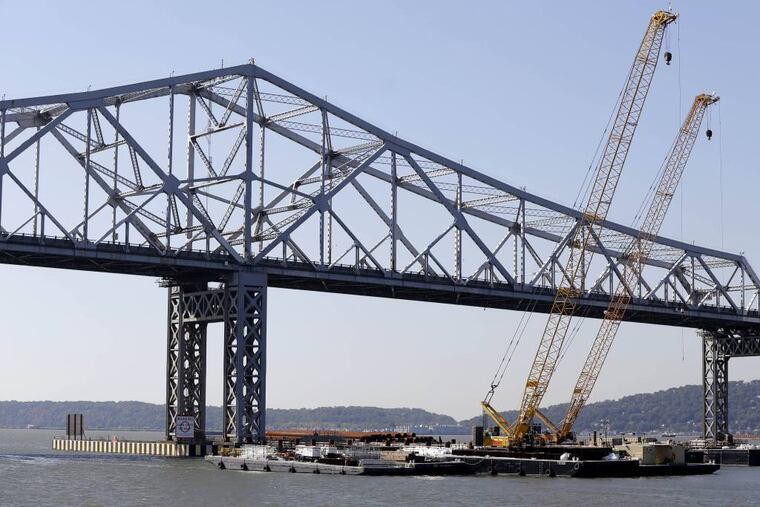Buy a bond, get a green card
A Washington state entrepreneur is seeking investors in China to help pay for a new $3.9 billion Tappan Zee Bridge, north of New York City, in exchange for a fast path to legal residence in the United States.

A Washington state entrepreneur is seeking investors in China to help pay for a new $3.9 billion Tappan Zee Bridge, north of New York City, in exchange for a fast path to legal residence in the United States.
Michael Mattox, a Seattle-area business developer, is using a controversial financing model that he first used on a smaller scale to help pay for a bridge in Washington.
His pitch to wealthy Chinese investors is essentially: Buy a bond, get a green card.
Agents in China have been promoting the proposal for weeks, complete with pictures of President Obama and New York Gov. Andrew Cuomo, and renderings of the future bridge.
In May, Obama used the Tappan Zee as the backdrop for his call for more federal spending on infrastructure.
Mattox and immigration lawyer Robert Divine, a former acting director of U.S. Citizenship and Immigration Services, created a company in New York to collect $500,000 payments each from Chinese investors.
The investors' money is to be used to buy bonds that will be issued by the New York State Thruway, which is financing construction of the new bridge.
The investors would then be eligible for "EB-5" immigration visas from the U.S. government for themselves and their families.
One of the Chinese-language websites advertising the Tappan Zee project proclaims, "100% government programs, financial security, a US green card beckons."
Congress created the Immigrant Investor Program in 1990 to give residency to foreigners who provide money to U.S. projects that will create at least 10 American jobs. The program was created to provide funding for private projects in the U.S., but increasingly has been used for public projects.
Usually, public agencies use EB-5 financing as a way to borrow money more cheaply. For example, the Pennsylvania Turnpike Authority struck a deal in 2013 to borrow money from an EB-5 lender to save $35 million in financing costs for construction of its connection to I-95.
But in the Tappan Zee project, there is no such advantage to the New York State Thruway.
Mattox's company, the New York Goldwater Regional Center, would use the foreign investors' money to buy bridge bonds at the going price, like any other investor.
Each Chinese investor would also pay about $50,000 in fees to the company and its agents and lawyers.
One of the Chinese-language solicitations for the project said an optimistic scenario is that EB-5 investors could provide 25 percent of the cost of the new bridge, or about $1 billion.
Thruway officials, who face the unpopular prospect of increasing bridge tolls to pay for the new bridge, said they were unaware of the Mattox proposal.
"As we continue to develop the financial plan for the new New York bridge, we are open to any ideas that will help us keep tolls on the new bridge as low as possible," said Thruway spokesman Dan Weiller.
In a similar investment arrangement in Washington state, Mattox created a company, Access the USA Regional Center, that used Chinese investors' money to buy $48 million in state bonds in 2011 to help pay for a bridge across Lake Washington, near Seattle.
But Mattox contends in a lawsuit that state officials prevented his company from buying an additional $143 million in bonds in 2012 "to avoid any negative association that might come from allowing a large investment in the . . . project by Chinese investors."
State officials deny Mattox's claim, saying they had no role in determining who bought the bonds.
Mattox's critics contend his financing plan undermines the rationale of the EB-5 program, to use foreign money to create American jobs in private projects.
"Giving a guy a green card for buying a bond - from a policy perspective, isn't that objectionable?" said Henry Liebman, a competitor of Mattox's in the EB-5 immigration business in Washington. "If this keeps going, why would anyone do private investment? It's all going to be public infrastructure."
Mattox, who declined to discuss specifics of the Tappan Zee project, dismissed critics of his bond-buying model.
"They don't like competition? They don't like ingenuity? What industry ever wants to change?" he said Monday. "They could embrace it, or they could hold onto their buggy whips."
He said his investment model, developed for the Washington state bridge, "is a great way to help rebuild America."
"Seems to me to be a great way to design a program that brings immigrants who have resources to add to our economy and enhance our communities," he said.
The new Tappan Zee Bridge is being built next to the 60-year-old, three-mile-long bridge that it will replace.
The first of the new bridge's two spans is scheduled to open to traffic in December 2016, and the full bridge by April 2018.
215-854-4587
@nussbaumpaul